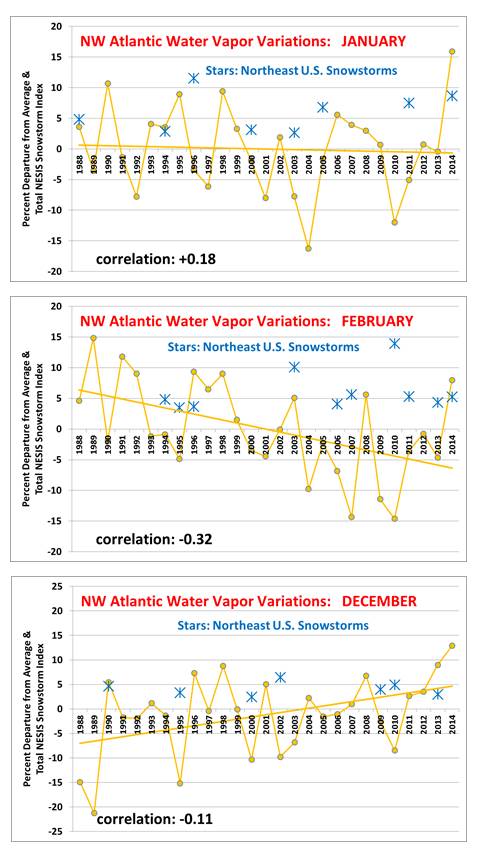One of the theories of how snowstorms can be made worse is that warming oceans provide more moisture for fuel.
While the theory sounds logical and even attractive, there are many ingredients that go into snowstorm formation. There has to be a synoptic scale disturbance feeding off the temperature contrast between the land and ocean, and since the land-ocean temperature contrast has actually DECREASED in the last several decades (if you believe the thermometer data), this would reduce the energy available for storm formation. (The “more-wavy” jet stream theory is highly suspect…without a greater temperature contrast, there is not as much thermal energy available for “baroclinic instability”).
Nevertheless, there do seem to have been more snowstorms in the Northeast U.S. in the last decade, so what might be the cause? As a meteorologist, my first inclination is to blame, in effect, “chaos”. Weather and climate variations are chaotic, there ARE weather patterns that can get set up and then persist. But these regional influences are basically disconnected from whether the global average temperature happens to be 1 deg. warmer or cooler. They are instead being driven by temperature contrasts of many tens of degrees.
But we can examine with observational data Kevin Trenberth’s hypothesis that increased Northeast snowstorms are the result of more water vapor from the North Atlantic.
For the last 27 years we have had the SSM/I and SSMIS instruments monitoring total water vapor content over the oceans every day. I took the Northwest Atlantic area from 30N to 50N, and 50W to 80W and examined the monthly average water vapor over this area versus the NESIS (Northeast Snowfall Impact Scale) index.
The results suggest basically no relationship between available water vapor and snowstorm events over the last 27 years:

There is little if any relationship between Northeast U.S. snowstorms and atmospheric water vapor over the Northwest Atlantic between 1988-2014.
In fact, while warm season water vapor has increased, cold season water vapor (if anything) has decreased on average over the region, making less vapor available for storms. The net trend through all seasons is about +0.5% per decade over the 27 year period.
There is always abundant water vapor available for U.S. snowstorms to feed off of, just as there is always abundant tropical water vapor available for hurricanes and typhoons. But that’s not the limiting factor in storm formation. What is necessary is the variety of conditions which can support the formation of low pressure centers….sufficient water vapor is usually ready and waiting to play its part.
It has more to do with the necessary temperature contrast between air masses (and in the case of tropical cyclones, vertical wind shear). And since global warming (no matter the cause) will lead to the continents warming faster than the ocean (reducing the energy for incipient storms), there is no convincing way to blame global warming for increasing snowstorm activity in the Northeast U.S.

 Home/Blog
Home/Blog




…viaje interestelar aceleracin constante (Tierra dentro de 500 M de aos)… al principio el Sol fusionando su Hidrgeno, temperatura suya, cuanto + H fusiona, + Helio se produce que al ser ms pesado se va concentrando en el centro aumentando presin y temperatura del ncleo, para no aplastarse la estrella empieza a fusionar ms H que antes sumentando as progresivamente su temperatura durante unos miles de millones de aos hasta casi el fin del H, donde empieza a los, mnimamente requeridos para ello, 10^8 C a fusionar el He…durante la secuencia principal con el paso del tiempo el Sol cada vez a + C… Venus que en los primeros 2000 Millones de aos era como la Tierra un volcnico aspirante a jardn paraso, que recibe asfixiante temperatura y se convierte en el sulfrico infierno actual… Dentro de 500 Millones de aos el Sol fusionando ms H y ms brillante, muy alta temperatura en Tierra, extremas sequas o inundaciones, unos millones de aos ms y agua que se evapora, gran aumento de vapor de agua atmosfrico con su efecto invernadero, ms y ms temperatura y vapor/calor, cada vez menos plantas y menos oxgeno, fin de la vida… Para entonces Humanidad ya con Enorme Progreso Cientfico-Tecnolgico que es exponencial: cuanto ms se progresa ms rpido se progresa, para Emigrar donde quiera: a los Exo-planetas, o tambin dentro de 5500 Millones de aos aqu mismo en el Sistema Solar a la para entonces alejada franja habitable “ricitos de oro”… Satlites como Titn hidrocarburos y agua congelados, de los planetas gigantes helados, con el Sol que ser entonces ya Gigante Roja, que evaporan sus ros de metano ((en las fotos de la sonda Huygens se ven rolling stones (lo que significa que tambin hay arena: cantos rodados, grava, y valiosa arena de ro para el hormign normal; la del desierto no vale para eso, ahora ya con el hormign-polmero, arena del desierto y plstico, ya s bloques para la construccin; en los ros de agua en Tierra, y en los ros de metano en Titn) y su nave nodriza Cassini que observ en los grandes lagos de metano lquido a -180 C burbujas ascendiendo a la superficie, debe haber por ello alguna fuente de calor en el fondo, quizs contraccin/expansin del rocoso ncleo por la inmensa gravedad de Saturno)) y son sustituidos por su Agua ya Lquida… Vida. Alguna de esas grandes lunas con sus hoy heladas densas Atmsferas que para entonces al calentarse perdern esa densidad pero… Para entonces ya dominada la Gravedad y a Planetas y Satlites Terraformar… Solo falta ya el Progreso Social sin Guerras, sin Religin (y renombrar todo), sin Patriotismo y sin ms Injusticias.